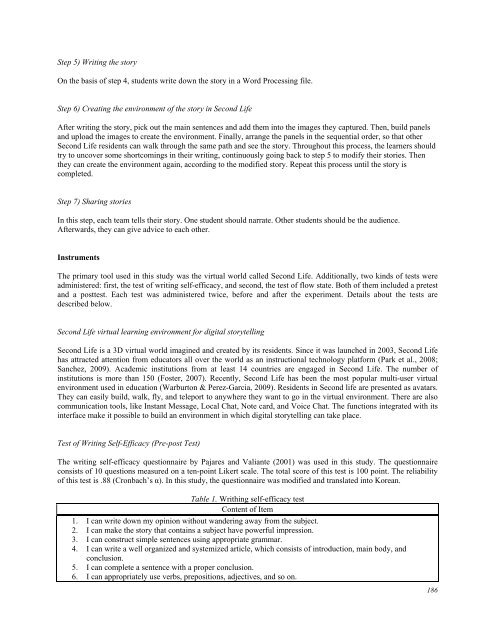October 2011 Volume 14 Number 4 - Educational Technology ...
October 2011 Volume 14 Number 4 - Educational Technology ...
October 2011 Volume 14 Number 4 - Educational Technology ...
You also want an ePaper? Increase the reach of your titles
YUMPU automatically turns print PDFs into web optimized ePapers that Google loves.
Step 5) Writing the story<br />
On the basis of step 4, students write down the story in a Word Processing file.<br />
Step 6) Creating the environment of the story in Second Life<br />
After writing the story, pick out the main sentences and add them into the images they captured. Then, build panels<br />
and upload the images to create the environment. Finally, arrange the panels in the sequential order, so that other<br />
Second Life residents can walk through the same path and see the story. Throughout this process, the learners should<br />
try to uncover some shortcomings in their writing, continuously going back to step 5 to modify their stories. Then<br />
they can create the environment again, according to the modified story. Repeat this process until the story is<br />
completed.<br />
Step 7) Sharing stories<br />
In this step, each team tells their story. One student should narrate. Other students should be the audience.<br />
Afterwards, they can give advice to each other.<br />
Instruments<br />
The primary tool used in this study was the virtual world called Second Life. Additionally, two kinds of tests were<br />
administered: first, the test of writing self-efficacy, and second, the test of flow state. Both of them included a pretest<br />
and a posttest. Each test was administered twice, before and after the experiment. Details about the tests are<br />
described below.<br />
Second Life virtual learning environment for digital storytelling<br />
Second Life is a 3D virtual world imagined and created by its residents. Since it was launched in 2003, Second Life<br />
has attracted attention from educators all over the world as an instructional technology platform (Park et al., 2008;<br />
Sanchez, 2009). Academic institutions from at least <strong>14</strong> countries are engaged in Second Life. The number of<br />
institutions is more than 150 (Foster, 2007). Recently, Second Life has been the most popular multi-user virtual<br />
environment used in education (Warburton & Perez-Garcia, 2009). Residents in Second life are presented as avatars.<br />
They can easily build, walk, fly, and teleport to anywhere they want to go in the virtual environment. There are also<br />
communication tools, like Instant Message, Local Chat, Note card, and Voice Chat. The functions integrated with its<br />
interface make it possible to build an environment in which digital storytelling can take place.<br />
Test of Writing Self-Efficacy (Pre-post Test)<br />
The writing self-efficacy questionnaire by Pajares and Valiante (2001) was used in this study. The questionnaire<br />
consists of 10 questions measured on a ten-point Likert scale. The total score of this test is 100 point. The reliability<br />
of this test is .88 (Cronbach’s α). In this study, the questionnaire was modified and translated into Korean.<br />
Table 1. Writhing self-efficacy test<br />
Content of Item<br />
1. I can write down my opinion without wandering away from the subject.<br />
2. I can make the story that contains a subject have powerful impression.<br />
3. I can construct simple sentences using appropriate grammar.<br />
4. I can write a well organized and systemized article, which consists of introduction, main body, and<br />
conclusion.<br />
5. I can complete a sentence with a proper conclusion.<br />
6. I can appropriately use verbs, prepositions, adjectives, and so on.<br />
186

















